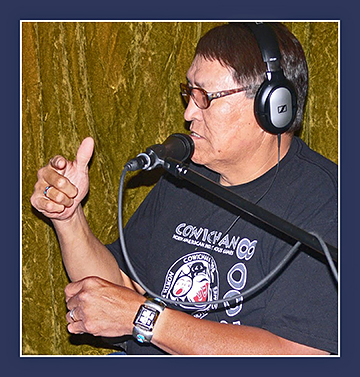Stoney Nakoda translator’s legacy affirms hope of Easter
COFFEE WITH WARREN, with Warren Harbeck
Cochrane Eagle, April 2, 2015

Quentin Lefthand, pictured here during a recording session of the Gospel of Luke in the Stoney Nakoda language, was passionate about his people hearing the story of Jesus in their own language. Photo by Lauren Runia
Perhaps it was because he saw in its words hope for the poor and marginalized. Perhaps it was simply because he was totally in awe of the hero of the story.
Whatever the reason, for Quentin Lefthand (1957–2011) there was nothing more important in all the world than communicating the Bible’s message of Jesus in his Stoney Nakoda language.
Quentin lived at Eden Valley, west of Longview, one of the three Stoney Nakoda First Nation communities along the foothills west of Calgary. (The other two are Big Horn, west of Nordegg, and Cochrane’s neighbour, Morley.)
In 2005 Quentin took the initiative to assemble a team of Stoney speakers and communication consultants to begin translating the entire Gospel of Luke into his language and to dub it over film footage from the The New Media Bible, a professionally produced video version of Luke.
He made especially good use of several members of the team from Morley who had earlier translated other parts of the New Testament into Stoney in print and audio formats, but not in video.
For the dubbing of Luke, Quentin provided the narrator’s voice. AV producer Jarret Twoyoungmen, of Morley, was the voice of Jesus.
(The entire video is available in 20 parts on YouTube. Search under the string “Stoney Luke pt.” Links to the 20 parts will appear; select the ones you’d like to view.)
Luke, the third of four New Testament accounts of Jesus’ life, is the gospel that pays particular attention to Jesus’ embrace of the marginalized: women, shepherds, prodigal sons, and yes, unique to Luke’s account, the story of the religiously marginalized Good Samaritan, society’s “Other” who reaches out across walls of hostility to help another human being in dire need.
Especially meaningful to me as we approach Good Friday and Easter is the Stoney account of three passages from Luke.
The first is the familiar teaching Jesus gave about how to respond to those who mistreat us (Luke 6:28). In Quentin’s Stoney version, Jesus says:
“Duwe hînîhne cha, dââ girha hînâ chegijigiya.” – “If someone hates you, do good to them and pray for them.” (Stoney Luke pt 8)
Some might ask, however: Considering how Jesus was mistreated, did He practice what He preached?
In those solemn crucifixion moments that lie at the heart of Good Friday services in Christian churches around the world, Jesus does indeed practice what He preached. For looking out from the cross toward the very people who had nailed Him to it, He prays (Luke 23:34):
“Ade Wakâ, wîchagijiktesîwo” – “My Father God, forgive them.” (Stoney Luke pt 19)
But it’s the concluding section of the Stoney Luke video (Part 20) that emphasizes the proof of Jesus’ unique identity and His authority to speak about forgiveness amidst life’s darkest hours.
Jesus has died and is buried in a tomb with a large, heavy stone rolled across the entrance. Early in the morning on the third day after the crucifixion, some women come to the tomb to anoint Jesus’ body with spices (Luke 24:1–8).
When they arrive, they’re distressed to find the stone mysteriously rolled away and Jesus’ body gone. Just then two angels appear and tell them the message that defines the very heart of what Easter is all about (Luke 24:6):
“Dako nen îgesîch. Nîyâ uno” – “He’s not here; He’s come back to life.” (Stoney Luke pt 20)
I’ll close our Holy Week column with one more reference unique to Luke: Jesus’ own mission statement (4:18). Quoting from the prophet Isaiah and underscoring the importance of Quentin’s life-giving legacy, Jesus declares (Stoney Luke pt 6):
“Warhe-îchine Nâri ne gichi mâûch, ûsibi ga wohnâgabi wathte ne owîchamaga chiyen” – “The Holy Spirit is with me to tell good news to the poor.”
© 2015 Warren Harbeck
JoinMe@coffeewithwarren.com